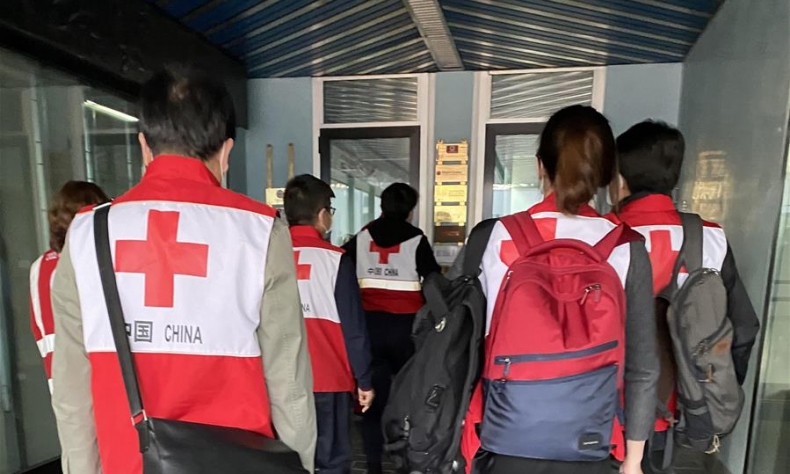Recognizing China’s Power of Resilience

Dr. Shamshad Akhtar lauds China’s efforts against COVID-19 and urges international cooperation.
Editor’s Note: Shamshad Akhtar, Policy Advisor to Secretary General of the Boao Forum for Asia (BFA) and former UN Under Secretary General, talked to the BFA on March 3 on China’s efforts against the novel coronavirus and its cooperation with the international community. Edited excerpts of the interview follow:
 It’s been a tough time for China since the novel coronavirus outbreak. How do you view the ongoing fight against the virus in China?
It’s been a tough time for China since the novel coronavirus outbreak. How do you view the ongoing fight against the virus in China?
Shamshad Akhtar: China is a great nation and its outstanding economic and social achievements are well recognized globally—lifting people out of poverty, transforming policies as well as legal and regulatory frameworks, embracing inclusive and sustainable development, and promoting global governance reform and multilateralism.
China invests heavily in research and development. Public health is of paramount significance to the authorities given the population size and density. China has a good track record of fighting epidemics though one needs to recognize that dealing with unknowns of the virus is a challenge and requires global cooperation and collective action to unearth the causes and treatment.
Given its decisiveness and determination, China has been successful in taking resolute actions. The World Economic Forum observes that China launched “the largest quarantine order in human history affecting almost 45 million people” and facilitated isolation of cities and infected cases.
Society and people at large are committed to fighting epidemics. Corporates and tech companies are playing their role, offering open platforms and tools for epidemic analysis, spotting persons under quarantine, donation, fast food delivery, healthcare knowledge and remote learning. Hi-tech and big data applications allow for solid analysis and help collective detection of body temperature in places with dense flow of people. Unmanned aerial vehicles are applied in epidemic prevention and control in more than 18 provinces. Artificial intelligence diagnosis has reduced the diagnosis time from 12 hours to 2 hours, and remote learning and teleworking systems provide students and business employees tools to study or work from home. China is investing a lot in these ventures and research and development of medicines and vaccines.
Our sympathies are with the people of China. Nations with strong leadership combined with people’s hard work and resilience can work collectively and effectively in times of crisis and emergency. Given the people’s potential and literacy, we are confident that like in other events in the past, the public will organize itself appropriately, supported by the right knowledge dissemination to control the spread of the epidemic.
How should the international community cooperate? What is your advice to the government and people of countries affected by the epidemic?
Epidemics are generally infectious and the transmission mechanism is multiple and unbeatable unless there are watertight controls, appropriate medical recourse and managed borders with testing facilities. Each of these areas is complex to manage and implement. In today’s world, with the deepening interconnectedness supported by the large multimodal transportation networks, it is not surprising that epidemics spread beyond borders.
Reports suggest that China’s prevention and control measures helped reduce the risk level in some areas, but it doesn’t mean the danger is over. There are still cases emerging and substantive potential risks that need continuous public health safety vigilance not only within China but across countries that have reported outbreak of different order and magnitudes. Nations are working to isolate the infected to contain the level of vulnerabilities. The virus knows no nationality, race or gender. More cooperation means less pain and faster relief. As the virus is spreading outside China, its experience and measures would come in handy and be valuable.
Public health infrastructure development, policy and its governance through effective regulation, learning exchanges, better risk management of cross-border mobility and medical cooperation are critical elements in fighting epidemics. The BFA has and will continue to sponsor consultations and deliberations to deal with the issue. While a coordinated and multi-pronged program of response is needed, it is essential to follow five principal areas:
First, there is need for global and collective action to address epidemics. The World Health Organization, being a global body, needs to play a more instrumental role in promoting coordination to prevent epidemics, containment of spread and support for mitigation of possible hazards. In this context, funding and expertise are crucial and more of official development assistance should be directed toward supporting countries and regions effectively, developing global teams to build capacities and knowledge of academics, and ensuring buildup of inventories of medical supplies, testing equipment and masks and protective suits.
Second, global funding for research and development to help with diagnosis and treatment options would go a long way in addressing epidemics as there are variant and new versions of epidemics and every time an outbreak occurs, it is often bigger than what was witnessed in the past.
Third, deployment of frontier technologies could play a significant role in advancing medical knowledge and controlling the spread of epidemics.
Fourth, ensuring public and private medical facilities are strengthened to deal with outbreaks and are geared for containment of epidemics with adequate equipment and trained staff.
Fifth, investments in population control, encouraging local governments to clean up markets and encouraging healthy eating habits.
What do you think of the impact of this epidemic on the economy of Asia and the rest of the world?
Signs are that the novel coronavirus outbreak has had an impact on the Asian economy and given regional countries’ strong weightage in global trade and output, it has consequences for global growth. It’s hard to predict with precision the course of the outbreak as data is still pouring in.
The novel coronavirus is now a key driver of disruptions within Asia whose impact will aggravate domestic macroeconomic vulnerabilities and the lingering effects of the U.S.-China trade war. A range of Asian economies’ first quarter growth forecasts have been revised downward. Even if the health threat recedes, the damage to economic confidence caused by the still escalating effects of this virus will linger on, hitting service, manufacturing and tourism sectors. Besides loss of output and trade, the cost of combating the outbreak must be further factored in.
China’s first quarter economic performance is impacted due to disruptions caused by much-needed containment which affects the movement of people, goods and services. China today is more globally and regionally integrated than in 2003 when the severe acute respiratory syndrome outbreak occurred. The impact is more pronounced on automotive, pharmaceutical and other industries that are export-oriented and depend on intermediate goods supplies from other parts of Asia.
The shutdown of China’s factories, slowdown of inbound and outbound transportation and disruptions to logistic services prompt concerns regarding a near-term impact on Asia’s production and supply chains. For instance, 80 percent of the exports of the Republic of Korea (ROK) to China are intermediate goods. In parallel, lower demand from China for goods impacts other Asian economies’ export, service and tourism sectors.
Interdependence within the manufacturing sector is also significant in Asia, both in information and communication technology (ICT) and transport. In case of ICT, Asia’s manufacturing sector relies heavily on China for its supplies of intermediate goods. For example, the ROK alone imports 36 percent of its ICT intermediate goods from China.
Many assessments and scenarios of economic impact are out there. It is estimated that given Asia’s strong production and trade interlinkages, China’s growth alone will be lower by anywhere between 0.4-0.8 percentage point and global growth accordingly would be 0.1-0.5 percentage point lower. The International Monetary Fund expects that the impact will be modest and short-lived and there could be V-shaped recovery, but it has qualified that uncertainty regarding the virus spread persists and would have economic implications. The Organisation for Economic Co-operation and Development has adjusted downward estimates of Japan’s growth by 0.4 percentage point, and the ROK and the eurozone by 0.3 percentage point.
As firm signs of virus containment emerges, China’s economic activity is resuming. The retail and food services sector is picking up and it is expected that automobile and industrial production will gradually improve. Authorities are facilitating recovery through incentives while relaxing controls on movement of people and goods. These measures together are expected to facilitate resumption of business operations and logistics.
The outbreak seems to have fueled anti-China sentiment with stigma and discrimination in some parts of the world. How to deal with it?
Politics can hurt people and nations. In the midst of the public health crisis and the emerging human tragedy, it would be more befitting for media outlets to focus on informing people of the real facts, threats and risks. Rather than finger pointing or generating misinformation and sensationalism, the media should play a constructive role and give right information to the public on prevention and containment measures to arrest epidemic spread, explore and implement mitigation options, and inform them where they can seek help and how communities galvanize self-protection to fight epidemics. The need of the hour is to rise above nationalism and rivalries and promote global solidarity.
To be constructive, it is important to learn from China’s practical experience that helped in government and social mobilization across the country to fight the epidemic. China has been recognized for the institutionalization of the emergency response mechanism and social mobilization systems, creating strategic assets in megacities, improving the competence of community-level officials and raising public health awareness. Its medical treatment of the disease works. China will be able to see a turning point. The world will again recognize the power of its people’s resilience.
 Facebook
Facebook
 Twitter
Twitter
 Linkedin
Linkedin
 Google +
Google +










